Download
iTunes
Index
Conventional
Hyperfractionation
Concomitant boost
|
TDFCalc is an application for your iPhone or iPod Touch handheld device which implements a form of the linear-quadratic (LQ) model suitable for comparing conventional external beam radiation therapy (EBRT) fractionation regimens. TDFCalc is not as comprehensive as TDF Plan but does provide a quick solution to the most common clinical task: that of estimating the fraction size for a nonconventional fractionation regimen (e.g. hypofractionation) which will be biologically equivalent to a well established conventional regimen. The tutorials below demonstrate how to use TDFCalc to perform some of the example calculations found in Time, Dose, and Fractionation in Radiotherapy, chapter 22 in Radiobiology for the Radiologist, Fifth Edition, by Eric J. Hall, Lippincott Williams & Wilkins, Philadelphia, 2000, pp 397-418. |

|

|

|
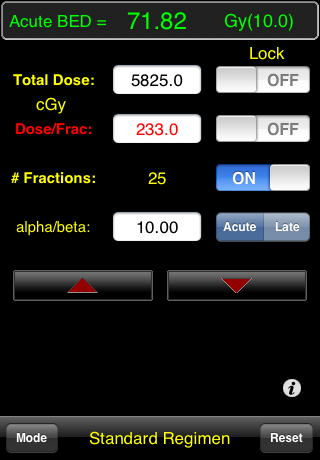
|
|
2. The biologically effective dose (BED) is an approximate quantity by which different fractionation regimens may be intercompared. It is calculated as: Assume a conventional treatment regimen of 30 fractions of 200 cGy given one fraction per day, 5 days per week, for an overall treatment time of 6 weeks. The BED for acute (early) effects is 72 Gy10 and 100 Gy3 for late effects. The subscripts to the Gy are reminders that BED is not in true physical Grays and is applicable only to the particular value of α/β used in the calculation. |
3. To compare acute effects for a schedule of 30 fractions with with a proposed schedule of fewer fractions, you must change the number of fractions in the calculator. You can work with any two of the three inter-related parameters (total dose, n, and d) by locking the parameter you wish to hold constant. Unlocked parameters have editable fields. The parameter currently highlighted in red can be bumped up or down in fixed increments using the large buttons with red centers. You can change the context of the red buttons by tapping the label to the left of the parameter you want to control. You can enter exact values by taping in the text field and using the virtual keyboard. BED is automatically updated when any input parameter (total dose, n, d or α/β) is changed. Lock the total dose field and change the new number of fractions to 25 as illustrated above. The dose/fraction will change automatically to maintain a (locked) total dose of 6000 cGy and the BED readout will automatically calculate 74.4 Gy10. |
4. Next, relock the number of fractions and reduce the dose/fraction field until the biologically effective dose returns to approximately 72 Gy10. If the assumption of an α/β ratio ≈ 10 Gy is valid, these two schedules should result in approximately equivalent acute biological effects. While it is permissible to compare the biologically effective doses calculated for acute effects (in Gyn) of one schedule with acute effects of other schedules (or, likewise, late vs. late effects), it is not permissible or meaningful to compare acute with late effects. Switch between acute or late effects by tapping the "acute" or "late" button next to the α/β field. |
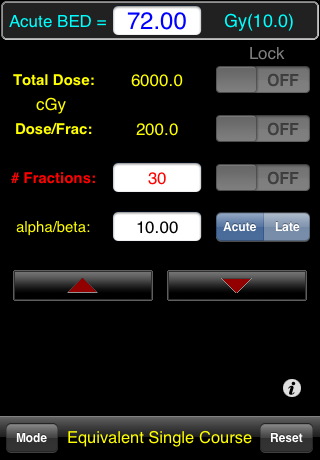
|
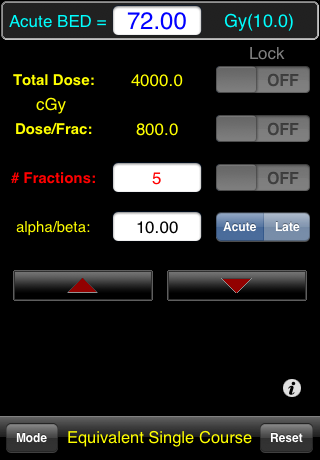
|

|
|
5. An easier way to calculate the dose per fraction for a nonconventional fractionation regimen is to first enter the conventional regimen in the Standard Regimen (SR) calculator and then tap the Mode button in the lower left corner which toggles between SR and Equivalent Single Course (ESC) modes. In ESC mode BED is held constant and fraction size is calculated as a function of the number of fractions. |
6. Upon entering ESC mode, the constant BED defaults to the whatever the current SR result is (72.00 Gy10 in this case) and also becomes an editable input parameter should you wish to enter a different BED vale. After you have specified the desired target BED, simply enter a new number of fractions, 5 in this example. The fraction size (and total dose) which yields the required BED for the specified number of fractions is automatically calculated. In this example the result is a total dose of 4000 cGy delivered in 5 fractions of 800 cGy per fraction. |
7. You can change the number of fractions using the red buttons or by tapping in any editable text field and directly entering a number using the device's virtual keyboard. Tap the Done button to complete your keyboard entry. |
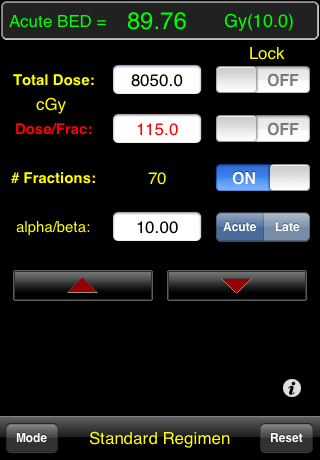
|
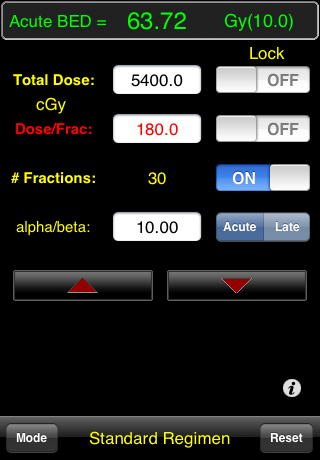
|
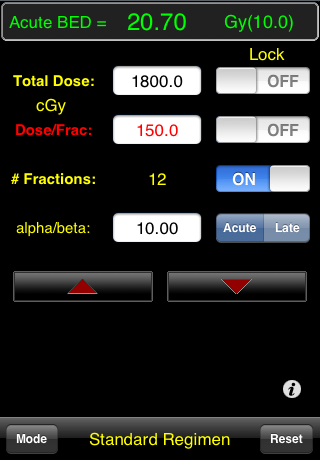
|
|
8. This is an example of hyperfractionation. For 70 fractions of 115 cGy given twice daily (BID), 6 hours apart, 5 days per week the biologically effective dose is 89.76 Gy10 for early effects and 111.4 Gy3 for late effects. This treatment is much "hotter," ie more effective than the conventional for both early and late effects. |
9. To calculate the biological effectiveness of a concomitant boost of 30 fractions of 180 cGy given once a day, 5 days a week and at the same time (concomitant) a boost to a smaller field of 12 fractions of 150 cGy once a day, you simply add the individual components. The primary component has a biological effectiveness of 63.72 Gy10 for acute effects. |
10. The boost component has a biological effectiveness of 20.70 Gy10. The concomitant treatment has a biological effectiveness of 63.72 Gy10 + 20.70 Gy10 = 84.42 Gy10 for acute effects and 113.4 Gy3 for late effects. The Gyn values should be compared with the comparable values for the alternate schedules. For the example in this tutorial, the concomitant boost is hotter than the conventional schedule for both acute and late effects. Compared with hyperfractionation, however, the concomitant boost is almost the same for late effects but less effective for acute effects, including tumor control. |